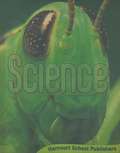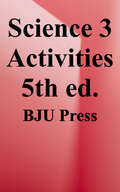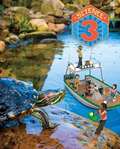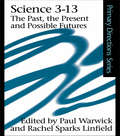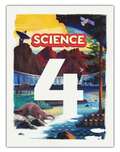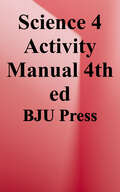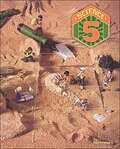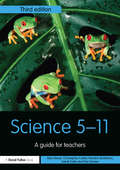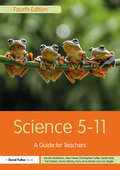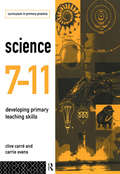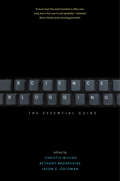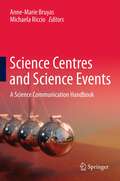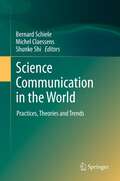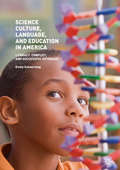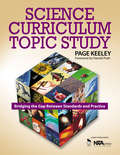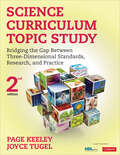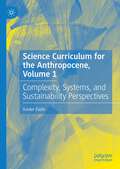- Table View
- List View
Science
by Randy Bell Malcolm B. Butler Kathy Cabe TrundleTwenty American academics, researchers, and high school science teachers contribute nine chapters offering secondary science educators--from seasoned educators to those who are early in their career--suggestions on how to change their teaching methods to prepare students for life and work. Topics addressed include inquiry, implementing change strategies, the role of curriculum materials in reform, building leadership teams to create professional learning communities, building partnerships to support reform, using data from student assessments, and addressing the needs of linguistically diverse students . Annotation ©2009 Book News, Inc. , Portland, OR (booknews. com)
Science
by Randy Bell Malcolm B. Butler Kathy Cabe TrundleNew computer-based technologies have revolutionized scientific research in recent years, yet computers remain curiously underutilised in many science classrooms. This engaging book shows you how to tap into the power of these new technologies to motivate students and support and enhance your existing curricula. Discover ways to use digital cameras, online databases and interactive simulation software to promote the kind of conceptual understanding and inquiry that drives real-world science. The 15 units on topics such as cell division, virtual dissection, earthquake modelling and the Doppler effect provide teachers with dozens of activities and lesson extensions in all of the major secondary school science areas. The units are introduced by essays that discuss project-based learning strategies, the creation of assessment rubrics and general guidelines for integrating technology in science instruction. Transform Your Science Classroom with Technology All units are keyed to the NETS. S Standards. Interdisciplinary links, teaching tips, lesson extenders and assessment guidelines are provided for each unit. Each unit includes a comprehensive listing of online and print resources for background reading and further exploration.
Science & Life Issues
by University of California at Berkeley Lawrence Hall of ScienceNIMAC-sourced textbook
Science (Grade #5)
by Harcourt School PublishersThis book is comprised of lessons of Life Science, Earth Science and Physical Science in an easy-to-learn format.
Science (Grade #6)
by Harcourt School PublishersThis text book contains unit lessons on Understanding Living Things, Interactions in Ecosystems, Exploring Earth, Cycles on Earth and in Space, Matter and Energy and Forces and Machines.
Science 10th Standard - Tamilnadu Board
by Training State Council of Educational ResearchScience Textbook for the 10th Standard Students preparing for Tamil Nadu State Board Exam.
Science 3 Activities
by Bju PressThe activities engage the students through reinforcement, enrichment, review, STEM, inquiry, and project- and problem-based learning activities. The students will gain an understanding of the concepts taught as they experience science. Investigation, Inquiry, Exploration, and STEM activities reinforce and explore the topics discussed. Each chapter includes study guides to provide systematic review of key concepts and prepare the student for the chapter assessment.
Science 3 Student Text
by Bju PressScience 3 Student Text (4th ed.) provides age-appropriate scientific information through text, diagrams, and charts, as well as captioned photographs, illustrations, and special interest boxes. Each section ends with Quick Check questions to assess student understanding. The first pages lay a foundation building a biblical worldview. A glossary and index are located at the end of the book.
Science 3 Student Text 4th Edition
by Bju PressBJU Press' Science 3 student text covers the basics of elementary-level earth science, life science, and physics; chapters on cold-blooded animals, warm-blooded animals, plants, ecosystems, matter, sound, energy in motion, weather, skin and more are written in an age-appropriate way that's easy for young children to comprehend. Interesting sidebars, "Quick-Check" questions to assess student understanding at the end of each section, illustrations, and other helpful elements are integrated throughout. 244 indexed pages, with glossary and index, softcover. 4th Edition. Grade 3. BJU Press was formerly called Bob Jones; this resource is also known as Bob Jones Science Grade 3 Student Text, 4th Edition.
Science 3-13: The Past, The Present and Possible Futures
by Paul Warwick Rachel Sparks LinfieldWhich factors have been influential in developing science teaching and learning for the three to thirteen age group in the last twenty years? How might these factors have an impact on the future direction of science teaching and learning for this age range into the 21st century? How can teachers cope with the changes?Science 3-13 explores some of the historical antecedents of the current position of science in the lives of younger children. It covers the various influences, both from within and outside the teaching profession, that have shaped the current science curriculum. Current practice is examined and, on this basis, speculations are made about the future position and direction of this important subject.The contributors each cover a particular aspect of science for the 3-13 age range but common themes emerge such as the influence of government intentions, particularly through the development of the National Curriculum. The role of research groups and the impact of ICT on the teaching profession as to what is important to teach and how science and science teaching should be viewed within society are shown to be important factors in the mix that contributes to change.This book forms part of a series of key texts which focus on a range of topics related to primary education and schooling. Each book in the Primary Directions Series will review the past, analyse current issues, suggest coping strategies for practitioners and speculate on the future.
Science 4
by Bju PressIn BJU Press’ Grade 4 Science 5th Edition, students will explore Life Science as they learn about plants, animals, humans; Physical Science as they study energy, waves, light, and sound; and Earth Science as they cover water, natural hazards, and natural resources, all from a biblical perspective. <p><p>The Student Text is full of full-color photographs, maps and diagrams, and each chapter begins with a vocabulary list and an essential question that is answered in the text. Questions within each section help to assess comprehension. Enrichments include sidebars on scientists and STEM careers. There are also “Try It Yourself” activities within each chapter so students can discover concepts for themselves. <p><p>Assignments also include larger scientific projects and activities so students can connect scientific principles with real-world problems. The Teacher Edition is sold separately. 456 pages, softcover. Grade 4.
Science 4 Activity Manual
by Bju PressScience 4 Activity Manual, 4th ed., provides a variety of pages to aid the students' understanding. Pages for recording information for Activity and Exploration lessons reinforce scientific methods. Each chapter includes Study Guides to provide systematic review of concepts for mastery and test preparation as well as Thinking It Through application questions. The Preview page for each chapter can be used to assess students' prior knowledge. Study Skill, Reinforcement, and Expansion pages are also included.
Science 5-11: A Guide for Teachers (Primary 5-11 Series)
by Christopher Collier Dan Davies Alan Howe Sarah Earle Kendra McMahonThis third edition of the bestselling textbook Science 5–11 has been fully updated to provide a synthesis of research and best practice in teaching and learning that focuses on successful ways to engage and motivate young scientists. Responding to the new curriculum, particularly ‘Working Scientifically’, this edition now includes: New sections on whole-school assessment, mentoring, transitions and a topics-based approach. Reference to the ‘big ideas’ of biology, chemistry and physics with chapters clearly related to this new subject structure. Updated tables of progression in each topic area and reference to cross-curricular contexts. New self-assessment questions for teachers, the option for higher-level thinking and further reading. An updated chapter on subject leadership with an increasing emphasis on monitoring progress. Bringing together research undertaken from a range of activities in the field, this book forms a comprehensive and clear guide, outlining the subject knowledge that a teacher needs, the curriculum requirements and the best ways to go about teaching. A practical guide ideal for students, trainees, mentors and other practising teachers, the book provides information on appropriate science topics for Key Stage 1 and 2.
Science 5-11: A Guide for Teachers (Primary 5-11 Series)
by Dan Davies Alan Howe Chris Collier Sarah Earle Kendra McMahon Darren McKay Kerry-Anne Barber Lisa HowarthThis fully updated fourth edition of the bestselling textbook Science 5-11 provides a comprehensive introduction to current research and professional practice for teaching science in the primary school.Chapters are organised into five sections, first introducing theory and practice, then providing specific guidance on teaching topics in biology, chemistry and physics, and finally discussing supporting science across the whole school. Updates to the new edition include: Responding to recent changes in the Initial Teacher Education framework, discussion about cognitive science is integrated more fully throughout. Supporting all children's engagement in science by suggesting inclusive and creative ways of building and consolidating knowledge including making connections between topics and with the wider world. New discussion on planning to support pupil progression in scientific knowledge throughout their time at primary school, building on Early Years and preparing for transition to secondary school. Presenting current research and outlining guidance on best practice, Science 5-11 provides a guide to the subject knowledge, curriculum requirements and pedagogical techniques to successfully teach science within the primary school.
Science 7-11: Developing Primary Teaching Skills
by Clive Carre Carrie OvensAs one of the core areas of the curriculum, science provides particular challenges, especially to teachers working at the top end of the elementary school range. Science 7-11 invites science teachers working with preteens to examine their practice in the light of current research findings. Clive Carre and Carrie Ovens, both experienced primary teachers themselves, ask what teachers really need to know both about their subject and about their students in order to teach
Science Blogging
by Bethany Brookshire Christie Wilcox Jason G. GoldmanHere is the essential how-to guide for communicating scientific research and discoveries online, ideal for journalists, researchers, and public information officers looking to reach a wide lay audience. Drawing on the cumulative experience of twenty-seven of the greatest minds in scientific communication, this invaluable handbook targets the specific questions and concerns of the scientific community, offering help in a wide range of digital areas, including blogging, creating podcasts, tweeting, and more. With step-by-step guidance and one-stop expertise, this is the book every scientist, science writer, and practitioner needs to approach the Wild West of the Web with knowledge and confidence.
Science Centres and Science Events
by Anne-Marie Bruyas Michaela RiccioThe idea for this text stemmed from the fruitful experience gathered during the training course of 9 Nigerian university students organized in Naples from 3 to 18 September 2008 by the team of Fondazione IDIS-Città della Scienza under the project Science Centre Owerri. The training course turned out to be not only an educational opportunity to acquire knowledge and skills for these students, but also a real and practical tool that later led to the realization of the first Science Festival of Owerri in Nigeria in May 2009. This in turn sparked the idea of creating a highly practical handbook for those who want to face the challenge of developing new projects for the dissemination and socialization of science in developing countries. In these countries, the role of scientific education and training in schools is not sufficient to arouse scientific curiosity among young people and make the population aware of the importance of scientific knowledge in everyday life. Moreover science and technology are indispensable tools for people's empowerment and should be supported with actions that encourage curiosity about science and the intelligent use of technology to bridge the divide with developed countries. It is therefore necessary to set up activities that are carefully targeted to promote and communicate science. The text has been designed as a practical guide to be used in a variety of contexts: scientific events or more structured science festivals, training, the creation of scientific cultural associations, and the development of new science centres. Besides being an excellent tool for training and supporting the design and planning phases, the manual can also be used as a reference work for institutions and local cultural services which have to select projects of this type.
Science Communication in the World
by Michel Claessens Shunke Shi Bernard SchieleThis volume is aimed at all those who wonder about the mechanisms and effects of the disclosure of knowledge. Whether they have a professional interest in understanding these processes generally, or they wish to conduct targeted investigations in the PCST field, it will be useful to anyone involved in science communication, including researchers, academics, students, journalists, science museum staff, scientists high public profiles, and information officers in scientific institutions.
Science Culture, Language, and Education in America: Literacy, Conflict, And Successful Outreach
by Emily SchoerningCan the culture and language of science be an alienating force that discourages marginalized people from identifying with scientists and pursuing higher education in the sciences? More broadly, does an education system which unwittingly presents science as a distinct culture result in a population susceptible to doubt, confusion, and denial? This volume explores how this 'culture of science' is reflected and transmitted in the classroom, and how this can have wide-reaching and often negative implications for science education and science literacy. Well-intentioned efforts to bring hands-on scientific experiences into the classroom must also take into account how students perceive the culture of science. Areas of potential conflict include linguistic and cultural behaviors, misconceptions about science and the nature of science, and, in some cases, religious worldviews. Once recognized, these conflicts are resolvable, and valid methods exist to reduce alienation, broaden participation, and ensure that all students, whether or not they pursue STEM careers, leave school knowing that science is something that they can trust.
Science Curriculum Topic Study: Bridging the Gap Between Standards and Practice
by Page D. KeeleyThis indispensable staff development resource provides a systematic professional development strategy linking science standards and research to curriculum, instruction, and assessment.
Science Curriculum Topic Study: Bridging the Gap Between Three-Dimensional Standards, Research, and Practice
by Page D. Keeley Joyce TugelToday’s science standards reflect a new vision of teaching and learning. | How to make this vision happen Scientific literacy for all students requires a deep understanding of the three dimensions of science education: disciplinary content, scientific and engineering practices, and crosscutting concepts. If you actively engage students in using and applying these three dimensions within curricular topics, they will develop a scientifically-based and coherent view of the natural and designed world. The latest edition of this best-seller, newly mapped to the Framework for K-12 Science Education and the Next Generation Science Standards (NGSS), and updated with new standards and research-based resources, will help science educators make the shifts needed to reflect current practices in curriculum, instruction, and assessment. The methodical study process described in this book will help readers intertwine content, practices, and crosscutting concepts. The book includes: • An increased emphasis on STEM, including topics in science, technology, and engineering • 103 separate curriculum topic study guides, arranged in six categories • Connections to content knowledge, curricular and instructional implications, concepts and specific ideas, research on student learning, K-12 articulation, and assessment Teachers and those who support teachers will appreciate how Curriculum Topic Study helps them reliably analyze and interpret their standards and translate them into classroom practice, thus ensuring that students achieve a deeper understanding of the natural and designed world.
Science Curriculum Topic Study: Bridging the Gap Between Three-Dimensional Standards, Research, and Practice
by Page D. Keeley Joyce TugelToday’s science standards reflect a new vision of teaching and learning. | How to make this vision happen Scientific literacy for all students requires a deep understanding of the three dimensions of science education: disciplinary content, scientific and engineering practices, and crosscutting concepts. If you actively engage students in using and applying these three dimensions within curricular topics, they will develop a scientifically-based and coherent view of the natural and designed world. The latest edition of this best-seller, newly mapped to the Framework for K-12 Science Education and the Next Generation Science Standards (NGSS), and updated with new standards and research-based resources, will help science educators make the shifts needed to reflect current practices in curriculum, instruction, and assessment. The methodical study process described in this book will help readers intertwine content, practices, and crosscutting concepts. The book includes: • An increased emphasis on STEM, including topics in science, technology, and engineering • 103 separate curriculum topic study guides, arranged in six categories • Connections to content knowledge, curricular and instructional implications, concepts and specific ideas, research on student learning, K-12 articulation, and assessment Teachers and those who support teachers will appreciate how Curriculum Topic Study helps them reliably analyze and interpret their standards and translate them into classroom practice, thus ensuring that students achieve a deeper understanding of the natural and designed world.
Science Curriculum for the Anthropocene, Volume 1: Complexity, Systems, and Sustainability Perspectives
by Xavier FazioThis volume, the first of a two-volume set, provides a foundation for future research and development in science curriculum. Drawing upon complexity and systems theories, this book provides a framework for science curriculum that tackles and transform the interrelated and socio-ecological causes of our ecological crises in the Anthropocene. Chapters provide a foundational conceptual framework that can inspire and motivate educators and researchers alike, and push the boundaries of science curriculum research, theory, and practice The result is a refreshing and hopeful look at PK-12 science curriculum as a lever for positive change amidst our current global trajectory in the 21st century.

